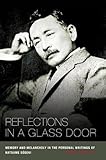Reflections in a Glass Door : Memory and Melancholy in the Personal Writings of Natsume Soseki / Marvin Marcus.
Material type: TextPublisher: Honolulu : University of Hawaii Press, [2009]Copyright date: ©2009Description: 1 online resource (280 p.) : 5 illusContent type:
TextPublisher: Honolulu : University of Hawaii Press, [2009]Copyright date: ©2009Description: 1 online resource (280 p.) : 5 illusContent type: - 9780824864095
- 895.6442
- PL812.A8 A2 2009
- online - DeGruyter
| Item type | Current library | Call number | URL | Status | Notes | Barcode | |
|---|---|---|---|---|---|---|---|
 eBook
eBook
|
Biblioteca "Angelicum" Pont. Univ. S.Tommaso d'Aquino Nuvola online | online - DeGruyter (Browse shelf(Opens below)) | Online access | Not for loan (Accesso limitato) | Accesso per gli utenti autorizzati / Access for authorized users | (dgr)9780824864095 |
Frontmatter -- Contents -- Acknowledgments -- Introduction: The Glass Doors of Natsume Sōseki -- Chapter 1. London Underground: A Rhetoric of Melancholy -- Chapter 2. Babashita Traces: Memories and the City -- Chapter 3. Shōhin Episodes: In Search of a Meiji Upbringing -- Chapter 4. Burdens of Domesticity: The Writer and His Family -- Chapter 5. Inside Glass Doors: The Writer at His Desk -- Chapter 6. Literary Portraits: Mentors, Protégés, and Eccentrics -- Chapter 7. Zōshigaya and Beyond: Re-membering Sōseki -- Afterword -- A Sōseki Chronology -- Notes -- Selected Bibliography -- Index
restricted access online access with authorization star
http://purl.org/coar/access_right/c_16ec
Much has been written about Natsume Soseki (1867–1916), one of Japan’s most celebrated writers. Known primarily for his novels, he also published a large and diverse body of short personal writings (shohin) that have long lived in the shadow of his fictional works. The essays, which appeared in the Asahi shinbun between 1907 and 1915, comprise a fascinating autobiographical mosaic, while capturing the spirit of the Meiji era and the birth of modern Japan.In Reflections in a Glass Door, Marvin Marcus introduces readers to a rich sampling of Soseki’s shohin. The writer revisits his Tokyo childhood, recalling family, friends, and colleagues and musing wistfully on the transformation of his city and its old neighborhoods. He painfully recounts his two years in London, where he immersed himself in literary research even as he struggled with severe depression. A chronic stomach ailment causes Soseki to reflect on his own mortality and what he saw as the spiritual afflictions of modern Japanese: rampant egocentrism and materialism. Throughout he adopts a number of narrative voices and poses: the peevish husband, the harried novelist, the convalescent, the seeker of wisdom. Marcus identifies memory and melancholy as key themes in Soseki’s personal writings and highlights their relevance in his fiction. He balances Soseki’s account of his Tokyo household with that of his wife, Natsume Kyoko, who left a straightforward record of life with her celebrated husband. Soseki crafted a moving and convincing voice in his shohin, which can now be pondered and enjoyed for their penetrating observation and honesty, as well as the fresh perspective they offer on one of Japan’s literary giants.
Mode of access: Internet via World Wide Web.
In English.
Description based on online resource; title from PDF title page (publisher's Web site, viewed 26. Apr 2024)


